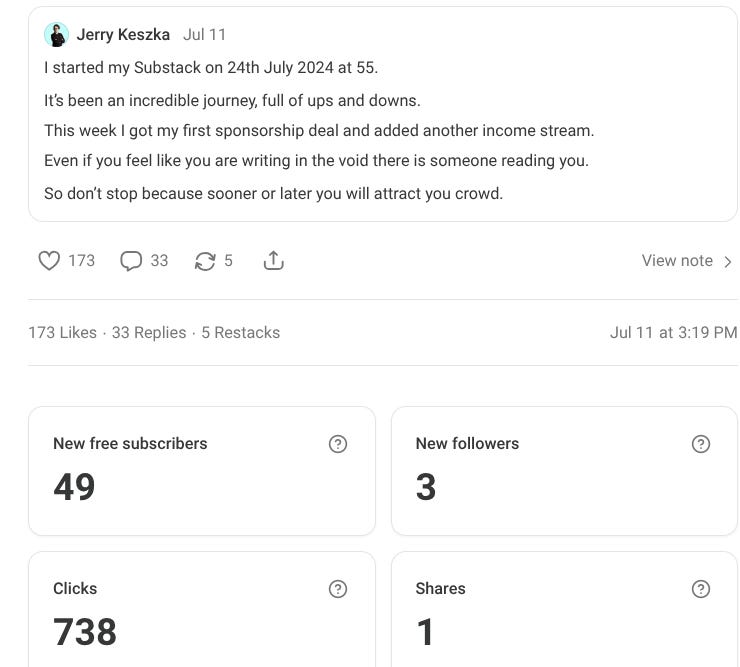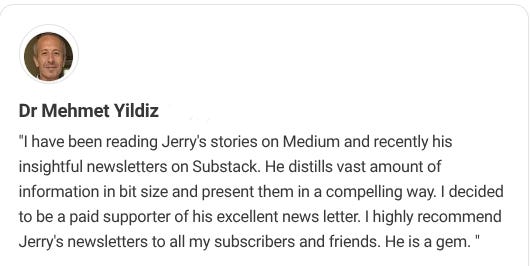9 Lessons I Learned After A Year on Substack That Will Help You Succeed
What I learned building a 5,000-subscriber community and 4 revenue streams in one year
Hey, wise adventurer,
Approximately 80-95% of Substack newsletters fail within the first year.
Today marks exactly one year since I posted my first newsletter on Substack.
What a ride!
Full of ups and downs, but here I am with a community of almost 5,000 subscribers and four income streams.
Thank you for being part of this incredible journey and making it possible.
I am genuinely grateful.
It was a bumpy ride at times. There is no success without failure and moments of doubt and confusion.
Two of my offers flopped, but I have learned that creating and selling digital products is easier than I thought. You can do it from the content you already have.
But if you, like me, are curious, believe in your mission, like testing new things, and are not afraid to fail, you will be fine.
It’s better to rock Substack than a chair!
One of my greatest successes is undoubtedly inspiring a community member to start his own Substack at the age of 70.
Today, I share nine lessons that I've learned after a year of being active on Substack, which will help you succeed.
Let’s go!
1. You Don’t Need a Website to Make Money.
Most people over 50 still employ outdated approaches to online business.
They spend time and money on non-important things like a website or a logo.
You can have the most beautiful and expensive website, but if nobody knows that it exists, you will never make any money. Period
All you need is traffic and paid clients.
Traffic is an audience that is interested in your content. Some of them may eventually become paid clients if you can help them solve their problem with your offer (something that you sell).
You can drive traffic by advertising. But if you are not an expert, you may lose money.
Instead, create an account on the platform where your target audience already exists. Just show them that you have precisely what they are looking for.
Or educate them. Because sometimes they don’t even realize what type of problem they have. And serve them with your solution.
What really matters are paid clients, not a fancy website or a logo.
2. Why Substack Beats Every Other Platform for Our Generation
I created four revenue streams using Substack.
Building and audience (engaged subscribers) are not vanity metrics. Because you can ask them what they want and validate your offers, the process speeds up and boosts its effectiveness for both sides.
It’s a win-win situation.
Substack has an advantage over other platforms.
Here is why:
- All-in-One Platform: Write, grow, monetize
- Low Tech Hassle: Focus purely on content
- Built-In Growth Tools: Natural referral system
- Direct Monetization: Multiple revenue streams
- Sell Subscription, Digital Products and Services
- True Community Building: Engaged readership
-Use Multiple Formats (Write, Audio, Podcast, Video)
Take advantage of using Substack because it’s currently in its growth stage.
But it’s not going to last forever.
3. You Will Quit Without an Offer.
Every business sells something.
But some reasons it feels cringy when a one-person business wants to get paid for the expertise. Seriously!?
If you think you never sold anything, that’s not true.
You sold your time and expertise to your previous employers.
Why not package your expertise and sell it to many people? That way, you can leverage your skills using the Internet and sell your skills to multiple clients 24/7, without any limits.
An offer is a solution (service, product, course, or software) you provide to your ideal consumer to solve one of their problems. In exchange, you get paid.
So many people start newsletters. They post consistently. They build audiences. But after 3, 6, or 12 months of creating content, they quit.
Why?
Because they don't have anything to sell.
You cannot build a sustainable online business without an offer. It's impossible.
You can write the most brilliant content in the world, but if you have no way to monetize it, you'll eventually burn out and quit.
Here is how to create your first $1,000 offer.
4. Don’t Treat Your Substack Like a Diary or a Journal.
I'm sure you have an interesting life and lots of exciting stories to share.
But treating your subscription like a personal journal is not a business model.
Many people have been writing for years without success because they don’t approach it as a business. And this is a way to lose motivation and burn out.
Being profitable doesn’t mean you should sound robotic, average, and boring. On the contrary, incorporate your personal stories into your content. That is what makes you special and helps you stand out from the crowd.
If you blend in and sound like everyone else, you will struggle to stand out and get noticed.
Treat Substack like a business if you want to make money.
5. Your Email List is The Only Asset That Truly Matters
Growing on social media today is like building a castle on sand.
A single algorithm shift or policy change can wipe out your audience overnight. I learned this lesson after losing 2,000 followers in my Facebook closed group.
Also fighting for attention with younger generations, who are dancing on TikTok and showing pouting lips on Instagram, is exhausting.
Use your experience, knowledge, and skills instead to build a sustainable business.
People buy from people whom they know, like, and trust.
Convert Kit's 2024 State of the Creator Economy revealed that newsletters and emails are the most popular content.
But even if you are not a content creator, you should have a newsletter. A nurturing email list is the basis of a sustainable business and growth.
Just look at the facts below:
- Email delivers 25-40% open rates vs. 1-3% social reach ( the lowest ever!)
- Escape the inconsistency of the social media algorithm
- Complete ownership of your audience
- Average ROI: $36 for every $1 spent
- Direct path to monetization
I used various methods and platforms to build an email list.
Currently, Substcak is the easiest platform for building and growing an email list.
But it’s not going to last forever.
6. Notes Are the Largest Growth Factor
Notes are similar to social media posts, but tailored specifically to Substack.
Using them is a fantastic opportunity to gain attention, receive or make comments, restack (share), and initiate collaboration.
Since Notes are a social media element, behave socially, even if you don’t feel like it. It can be your largest growth factor, bringing you new free and even paid subscribers, collaborations, and recommendations.
What’s not to like about it?
Even if you (like me) are not a big fan of social media.
To make the most of any platform, follow the rules. It’s like a game. But it can be genuinely fun. I enjoy interacting with interesting Notes and newsletters.
Treat every Note and newsletter as a data source. Click on → "View Stats" in the bottom right corner of your Notes, and view the data as shown in the screenshot below.
I follow the 10-5-1 rule at least 5 days per week. That means liking 10 posts, making 5 meaningful comments, and sending one direct message. Do this consistently, and you will notice the impact on your growth within 30 days.
Imagine what you can achieve in 6 months or a year.
7. Get Subscribers While You Sleep with Recommendations
Recommendations are the best way to borrow an audience and bring subscribers to your subscription without doing any additional work.
The numbers don’t lie.
Comment on other creators in a similar niche's posts, and if you like what they do, reach out and recommend their publications. Or you can even recommend them without needing to reach out. Some of them will reciprocate.
I strongly suggest messaging other creators directly, as it can lead to collaborations on posts. It’s a win-win situation for both sides.
Recommendations will only work if you make an effort first and reach out to others.
And enjoy the benefits later.
8. Invest In Yourself
I spent thousands on courses, books, e-books, masterclasses, and workshops.
And I pay for six subscriptions here on Substack.
Some of those educational materials were better than others, but I always learned something, and I have never regretted spending the money.
Spending money on improving your skills is not an expense.
It’s an investment.
9. It’s Never Too Late
I started my Substack last year at 55.
One of my community members just started his Substack newsletter at nearly 70.
There are more exciting stories from people who start in their 60s, pivot, and reinvent themselves in their 70s.
I will interview them and share their stories here.
Stay tuned and make sure to subscribe to receive it directly in your inbox.
Your Turn: Join the 5% Who Actually Succeed
After a year of testing, failing, and making it work, I've learned that the difference between the 95% who quit and the 5% who thrive isn't talent—it’s doing what moves the needle.
But with most advice directed at twenty- and thirty-somethings, it’s hard to cut through the noise. It’s overwhelming.
I know because I’ve been there, starting in my 50s, following the gurus' advice that wasn’t designed for our demographics.
That’s why I started Plus 50 Forward to deliver proven strategies for building sustainable online income, specifically designed for people with decades of experience and real-life skills.
What others say about Plus 50 Forward
Starting at 55 taught me one thing: we don't need to reinvent the wheel. We just need proven strategies that work for people with our experience and priorities.
Ready to skip the trial-and-error phase and get straight to what works?
P.S.
I would love to hear your stories about starting on Substack.
Hit reply and share.










Hi there! THANK YOU!!! Such an inspirational post! And very timely...for me. I am a proud member of the 50+ club. I've just started taking this Substacking thing seriously about a month ago. I've gained--and lost--one subscriber during that time😂. (I laugh to not cry. lol.) Subscriber Grand Total (cue drum roll)...nine. Yep. 9. Again, thanks for the great advice and motivation. I will certainly employ your advice and continue my journey. Nowhere but up from here.
Jerry, I believe the most helpful document I've seen from you so far is "Simplifying Digital Success After 50: The Guide to Digital Business Without the Overwhelm." I'm starting to follow it. Since this is Oct 1, I'm going to follow it through Oct 30. It's clear. Since I fight overwelm big time, I'm putting on the "blinders." Pun partly intended, and taking it at its word.